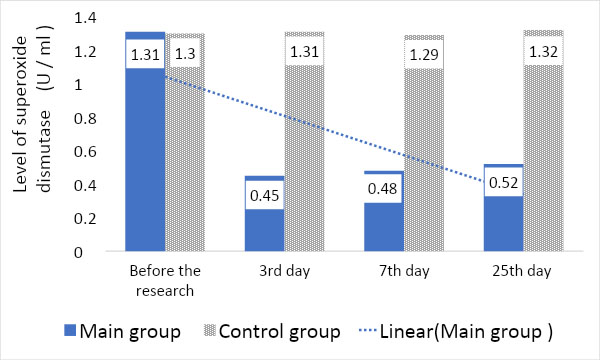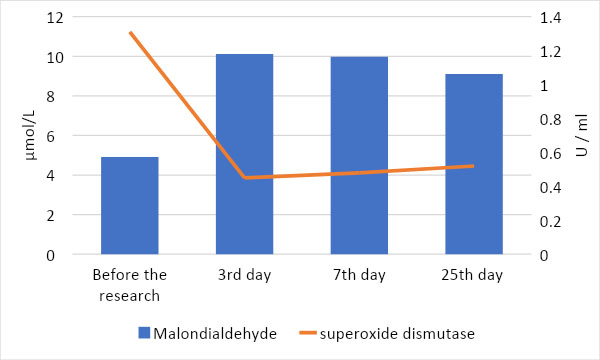- Home
- About the Journal
- Peer Review
- Editorial Board
- For Authors
- Reviewer Recognition
- Archive
- Contact
- Impressum
- EWG e.V.
Cite as: Archiv EuroMedica. 2022. 12; 3: e1. DOI 10.35630/2199-885X/2022/12/3.2
In people worldwide, chronic periodontitis occurs in 10-15% of cases. Prolonged inflammation of periodontal tissues contributes to the formation of oxidative stress. The purpose of this study was to evaluate the level of malondialdehyde and superoxide dismutase (as indicators of oxidative stress) in periodontitis in rats. For this, in the main group of rats (n=10) a model of ligature periodontitis was created. The control group of rats (n=10) was intact. As a result, in periodontitis, the level of malondialdehyde doubled. We also found an inverse relationship between the level of lipid damage and superoxide dismutase activity.
Conclusions. The level of metabolites of redox processes is significantly increased in periodontitis. This confirms a significant increase in the indicators of malondialdehyde. A decrease in superoxide dismutase activity leads to a low antioxidant status in rats.
Keywords - periodontitis, periodontal diseases, malondialdehyde, superoxide dismutase, oxidative stress.
Periodontitis is a disease that is accompanied by destruction of the tissues that hold the tooth. Periodontitis occurs in every tenth adult. There are many reasons that lead to the development of periodontal tissue inflammation [1]. The most common causes of periodontitis are the presence of plaque with microbes, metabolic disorders, diseases of the cardiovascular system, diabetes mellitus, etc. [2, 3].
Recently, many specialists have begun to pay attention to the increased formation of reactive oxygen species (ROS) in various diseases [4]. Reactive oxygen species are free radicals that are formed as a result of metabolic processes in cells. Normally, in the body of mammals, there is a balance between the production and neutralization of ROS, which is maintained by a protective antioxidant enzyme system: superoxide dismutase, catalase, and peroxidase [5, 6]. Consequently, with a decrease in the activity of the antioxidant defense of the body, cells are damaged by reactive oxygen species. An imbalance between ROS and antioxidant enzymes occurs due to an increase in leukocyte activity, which is enhanced in inflammatory diseases, including periodontitis [7]. Therefore, the study of the antioxidant defense system in inflammatory periodontal diseases is a promising area of modern dentistry.
Aim. To assess the level of oxidative stress metabolites in periodontitis in rats
An experimental study was performed on 20 healthy outbred rats aged 12 to 16 weeks and weighing 180 to 230 g. All procedures with animals were performed according to the the Guidelines for the care and use of laboratory animals. All rats were divided into two groups:
control group (n=10) - animals that were under observation and were not manipulated;
the main group (n=10) - animals, used to create a model of periodontitis.
We performed all manipulations in animals under general anesthesia (zoletil 0.03 ml IM). The model of periodontitis was created by placing a ligature thread (Vicryl 5.0) between the two maxillary molars on the left. This ligature was a long-term irritant for the gums and periodontal tissues, caused the accumulation of bacterial plaque, contributed to the destruction of bone tissue, which led to the development of periodontitis after 1 month.
As a marker of oxidative stress, we assessed the level of malondialdehyde in the blood serum (analyzer Fluorat-02-ABLF-T, Russia). We studied the level of the antioxidant defense system in rats by changes in the activity of the superoxide dismutase enzyme.
Monitoring of the results was carried out after the modeling of periodontitis and removal of the ligature on days 3, 7, 25. All animals of both groups ate soft food and were kept in the same conditions throughout the experiment.
Statistical processing was carried out with the calculation of arithmetic mean values (M) and their errors (m). The reliability of differences in the groups was calculated.
We observed a sharp increase in malondialdehyde by 51.5% in rats of the main group on the third day after removal of the ligature compared with the initial values (p<0.001). Such a significant jump in the indicators of malondialdehyde indicates hyperactivation of lipid oxidation processes. On the seventh and twenty-fifth days, malondialdehyde values tended to decrease slightly, which can be explained by the elimination of the periodontal tissue irritant, the ligature (Table 1). However, the level of malondialdehyde in rats of the main group remained significantly higher compared to the initial values, which indicates ongoing oxidative stress in the periodontium.
At the same time, we observed a sharp decrease in the activity of the superoxide dismutase enzyme in the main group of animals by almost three times (p < 0.001) on the third day after the removal of the ligature (Fig. 1). The low activity of superoxide dismutase in rats of the main group persisted throughout the experiment and significantly differed from the control group (p<0.001). We recorded an inverse relationship between the levels of malondialdehyde and superoxide dismutase in the main group of animals (Fig. 2).
Table 1. The level of malondialdehyde (mmol/l) in the blood plasma of animals of both groups
| Observing days Animal groups | Before studies | 3 day | 7 day | 25 day |
| Control group (n=10) | 4,93±0,28 | 4,92±0,21 | 4,93±0,24 | 4,94±0,18 |
| Main group (n=10) | 4,91±0,32 | 10,11±0,77 | 9,98±0,59 | 9,11±0,51 |
| р | p>0,05 | р <0,001 | р <0,001 | р <0,001 |

Fig. 1. Indicators of the level of superoxide dismutase (u/ml) in the blood plasma of animals of the main and control groups

Fig. 2. Dependence of the level of malondialdehyde on the activity of superoxide dismutase
ROS are markers of redox processes in the cell. ROS are derivatives of molecular oxygen that have the ability to damage cells (proteins, lipids and DNA). An increase in the level of ROS is a sign of the body's response to various bacterial damage and injury. Malonic dialdehyde serves as a marker of lipid peroxidation. Therefore, malondialdehyde can be considered an indicator of the level of oxidative stress. Kocaman G. et al found a statistically significant increase in the level of malondialdehyde in rats with periodontitis induced by ligature ligation of the upper right first molars (p < 0.005) [5]. Aytekin Z. et al. also proved that animals with periodontitis experience oxidative stress [8]. This fact was confirmed by the high level of malondialdehyde in the blood serum of these animals [8]. Moreover, the authors found that malondialdehyde levels were significantly reduced by antioxidant therapy.
Our study confirmed that oxidative stress is present in rats with periodontitis. In periodontitis, the animals had an almost twofold increase in malondialdehyde compared to the control group (p<0.001). Moreover, we found an inverse correlation between the indicators of malondialdehyde and superoxide dismutase in the main group of animals.
Rats experience oxidative stress after creating a model of ligature periodontitis. The depth of oxidative stress in periodontal diseases is evidenced by high levels of malondialdehyde and low activity of superoxide dismutase. The participation of oxidative stress in the pathogenesis of inflammatory periodontal diseases allows the use of pathogenetic therapy using antioxidant drugs.